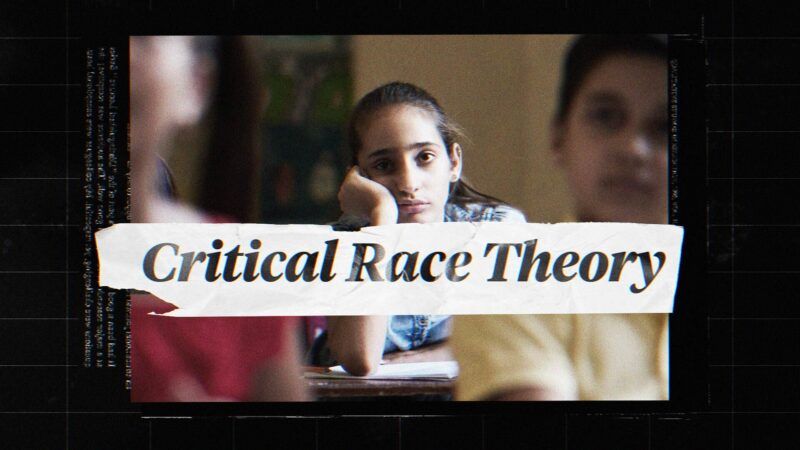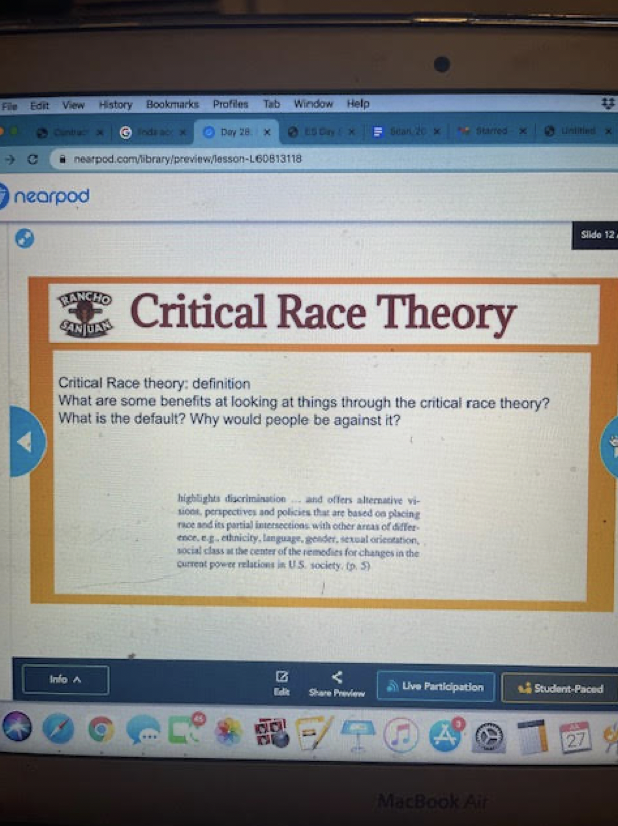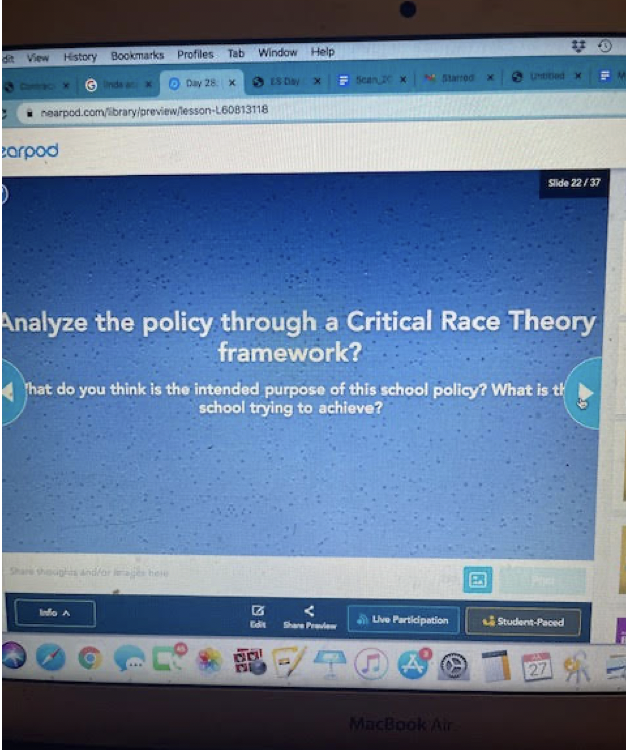Hispanic Students Were Forced To Learn Critical Race Theory. They Hated It.
Kali Fontanilla discovered that not only was CRT being taught in the classroom—her minority students were failing it.

During the 2020 fall semester, Kali Fontanilla—a high school English language teacher working in the Salinas, California, school district—noticed that many of her students were failing one of their other classes: ethnic studies. This was at the height of the pandemic, and instruction was entirely online, leaving many students in the lurch. Still, Fontanilla thought it was odd to see so many Fs.
Salinas has a majority Mexican population; all of Fontanilla's students were Hispanic and were learning English as a second language. Education officials who propose adding ethnic studies to various curriculums—and making it mandatory, as the Salinas school district did—typically intend for privileged white students to learn about other cultures. There's a certain irony in requiring members of an ethnic minority to study this, and an even greater irony in the fact that such students were struggling intensely with the course.
"My students are failing ethnic studies," says Fontanilla, who is of Jamaican ancestry. "I would say half of them are failing this ethnic studies class."
This made Fontanilla curious about what the course was teaching. All of the high school's teachers used the same online platform to post lesson plans and course materials, so Fontanilla decided to take a look. She was shocked by what she saw.
"This was like extreme left brainwashing of these kids," says Fontanilla. "Critical race theory all throughout the lessons, from start to finish. The whole thing."
Critical race theory, or CRT, has become a flashpoint in the debate about what kids ought to be learning in public schools. Originally an obscure, left-wing body of thought that mostly appeared in graduate schools, critics charge it with influencing diversity workshops for major corporations, training seminars for teachers, and even K-12 curricula. Parental concerns about CRT became a major flashpoint in the 2022 Virginia gubernatorial race. After winning the race and taking office, Republican challenger Glenn Youngkin's first act was to ban CRT.
Many adherents of CRT deny that it's taught to primary education students, and the mainstream media have been quick to line up behind such claims. That's why Fontanilla's discovery was so significant.
"The teacher had the kids all learn about the four I's of oppression," says Fontanilla. The four I's were institutional, internalized, ideological, and interpersonal oppression. "And then there was a whole presentation on critical race theory and they actually had the students analyze the school through critical race theory."
Slides from lesson plans provided by Fontanilla confirm that the ethnic studies course references critical race theory by name.


The original meaning of the theory, at least when taught at the college level, is that racism so pervades U.S. society and U.S. institutions that it is impossible to separate race from other issues: All policies, structures, and laws were built under the auspices of racism, a sort of original sin that shapes the country's institutions. In common parlance, opponents often use the term "CRT" to refer a broader set of concepts, like intersectionality—the idea that there are different kinds of oppression that all stack on top of each other—and privilege.
"The kids don't even want this stuff," says Fontanilla, noting that the ethnic studies course replaced a much more popular health class—in the midst of a pandemic, no less. "Most of them are just like, 'Why do we have to take this class?'"
They would have to direct that question to California Gov. Gavin Newsom and the state's Democratic-controlled legislature, which decided to mandate ethnic studies for all public schools. Newsom vetoed a previous mandate, which came under fire because the proposed curriculum included "jargon such as 'cisheteropatriarchy' and 'hxrstory,' and refers to capitalism as a form of power and oppression alongside white supremacy and racism," according to Cal Matters.
The legislature re-worked the ethnic studies proposal, and on October 8, 2021, Newsom signed the mandate into law. Beginning with the class of 2030, all public high school students in California will now have enroll in the same sort of course that Fontanilla's students already took.
In a statement to The Epoch Times, Dan Burns, superintendent of Salinas Union High School district, denied that the course was based on CRT, though he conceded that CRT "is addressed in our course as one of the frameworks within the K-12 Ethnic Studies Outcomes list."
Indeed, CRT is referenced in the district's ethnic course syllabus, which is available online. The syllabus stresses that students will study "intergenerational trauma" through an interdisciplinary and critical lens. Scholarly articles about critical race theory are included in the suggested curriculum, including "Whose culture has capital? A critical race theory discussion of community cultural wealth," by Tara J. Yosso, a UCLA professor of education who specializes in critical race theory.
One of suggested activities for students is an "intersectional rainbow."
"Students will rank their various identities with corresponding colored strings to create intersectional rainbows. Gender, race, class, ethnicity, sexual orientation, beliefs, nationality, ability, age, etc.," reads the syllabus. "Students will compare and contrast their intersectional rainbows with their peers, while framing their discourse within the intersectionality paradigm as laid out by Kimberlé Crenshaw."
Crenshaw, a Columbia University law professor, is widely recognized as one of CRT's founding figures. (Vanity Fair once called her the "mastermind of critical race theory.")
Other possible classroom activities include hosting a mock trial where they accuse various historical persons of being complicit in the genocide of Native Californians and "creating a social justice oriented counter-narrative."
Salina's version of the course included a "privilege quiz": Students were expected to rank themselves based on their marginalized status or lack thereof. The lesson plan included an image of two white girls—former Republican President George W. Bush's twin daughters, to be precise—at the top of the privilege hierarchy.
"Some people are born in third base and think they hit a triple," says Fontanilla, recalling the intended message of the exercise. "So basically, they were born on third base and they graduated college because they had a head start."
Many people might consider such activities to be a form of left-wing activism infiltrating the classroom . Fontanilla is one of them. As a Christian, a conservative, and a black woman, she doesn't believe that students—especially her students, learning English as a second language—need to be taught to check their privilege.
"It's hyper-race-focused," says Fontanilla. "And whenever there's hyper race focus, racism will follow."
Fontanilla decided that district parents had a right to know what was in the curriculum, and took steps to obtain the lesson plans so that she her job would not be at risk if she leaked them. But when the district handed over the documents, it omitted the slides that included the words critical race theory.
She decided to write a letter to the school board in protest of the ethnic studies curriculum. It was read aloud at a meeting on June 22.
"I do not appreciate constantly being pandered to and treated differently because of the color of my skin, especially since I did not have the freedom to not go along with it," Fontanilla wrote, warning that the curriculum was an attempt at left-wing indoctrination. The statement elicited cheers from other parents attending the meeting. In response, the school board prohibited anti-CRT comments at its next public gathering.
"You know it's something evil when they get so nasty defending it," says Fontanilla.
While she has received much praise for speaking out, Fontanilla has also endured considerable online harassment, including threats of violence. One told her to "have fun being a token black friend to racist conservatives your whole life."
"They're all basically white liberals," she says of the harassers.
Fontanilla had already decided that she could not remain a teacher in the school district; she and her husband decided to move to Florida, where she hoped to find a better job. The twin experiences of remote instruction during the pandemic and race-focused education has left her feeling cold about the teaching profession. She recalls that during the summer of 2020, in the midst of the George Floyd protests, the Salinas administration informed its black teachers—Fontanilla included—that they would be honored with a gift.
The gift, it turned out, was a mask bearing the message: Black Teachers Matter.
"I would never wear it in front of my students," she says. "I think especially if a kid isn't into Black Lives Matter and I'm wearing this Black Teachers Matter mask, that kid automatically knows they can't speak up in my class."
The gift also included an "I Love Being Black" sticker, and a letter with an ancient African greeting that "acknowledges the god in me and stuff like that."
"It was just so weird," she says.
